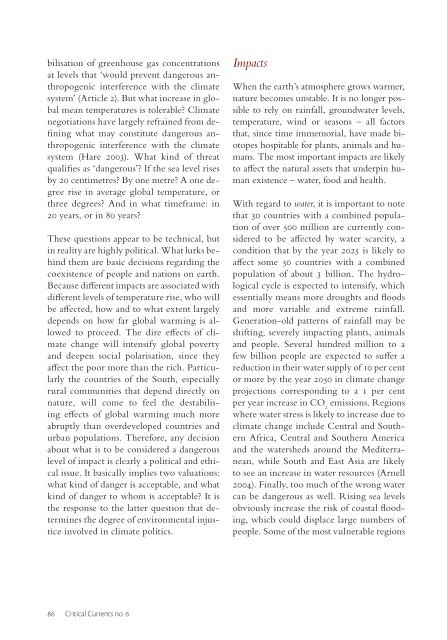Contours of Climate Justice - Dag Hammarskjöld Foundation
Contours of Climate Justice - Dag Hammarskjöld Foundation
Contours of Climate Justice - Dag Hammarskjöld Foundation
You also want an ePaper? Increase the reach of your titles
YUMPU automatically turns print PDFs into web optimized ePapers that Google loves.
ilisation <strong>of</strong> greenhouse gas concentrations<br />
at levels that ‘would prevent dangerous anthropogenic<br />
interference with the climate<br />
system’ (Article 2). But what increase in global<br />
mean temperatures is tolerable? <strong>Climate</strong><br />
negotiations have largely refrained from defi<br />
ning what may constitute dangerous anthropogenic<br />
interference with the climate<br />
system (Hare 2003). What kind <strong>of</strong> threat<br />
qualifi es as ‘dangerous’? If the sea level rises<br />
by 20 centimetres? By one metre? A one degree<br />
rise in average global temperature, or<br />
three degrees? And in what timeframe: in<br />
20 years, or in 80 years?<br />
These questions appear to be technical, but<br />
in reality are highly political. What lurks behind<br />
them are basic decisions regarding the<br />
coexistence <strong>of</strong> people and nations on earth.<br />
Because diff erent impacts are associated with<br />
diff erent levels <strong>of</strong> temperature rise, who will<br />
be aff ected, how and to what extent largely<br />
depends on how far global warming is allowed<br />
to proceed. The dire eff ects <strong>of</strong> climate<br />
change will intensify global poverty<br />
and deepen social polarisation, since they<br />
aff ect the poor more than the rich. Particularly<br />
the countries <strong>of</strong> the South, especially<br />
rural communities that depend directly on<br />
nature, will come to feel the destabilising<br />
eff ects <strong>of</strong> global warming much more<br />
abruptly than overdeveloped countries and<br />
urban populations. Therefore, any decision<br />
about what is to be considered a dangerous<br />
level <strong>of</strong> impact is clearly a political and ethical<br />
issue. It basically implies two valuations:<br />
what kind <strong>of</strong> danger is acceptable, and what<br />
kind <strong>of</strong> danger to whom is acceptable? It is<br />
the response to the latter question that determines<br />
the degree <strong>of</strong> environmental injustice<br />
involved in climate politics.<br />
86 Critical Currents no. 6<br />
Impacts<br />
When the earth’s atmosphere grows warmer,<br />
nature becomes unstable. It is no longer possible<br />
to rely on rainfall, groundwater levels,<br />
temperature, wind or seasons – all factors<br />
that, since time immemorial, have made biotopes<br />
hospitable for plants, animals and humans.<br />
The most important impacts are likely<br />
to aff ect the natural assets that underpin human<br />
existence – water, food and health.<br />
With regard to water, it is important to note<br />
that 30 countries with a combined population<br />
<strong>of</strong> over 500 million are currently considered<br />
to be aff ected by water scarcity, a<br />
condition that by the year 2025 is likely to<br />
aff ect some 50 countries with a combined<br />
population <strong>of</strong> about 3 billion. The hydrological<br />
cycle is expected to intensify, which<br />
essentially means more droughts and fl oods<br />
and more variable and extreme rainfall.<br />
Generation-old patterns <strong>of</strong> rainfall may be<br />
shifting, severely impacting plants, animals<br />
and people. Several hundred million to a<br />
few billion people are expected to suff er a<br />
reduction in their water supply <strong>of</strong> 10 per cent<br />
or more by the year 2050 in climate change<br />
projections corresponding to a 1 per cent<br />
per year increase in CO 2 emissions. Regions<br />
where water stress is likely to increase due to<br />
climate change include Central and Southern<br />
Africa, Central and Southern America<br />
and the watersheds around the Mediterranean,<br />
while South and East Asia are likely<br />
to see an increase in water resources (Arnell<br />
2004). Finally, too much <strong>of</strong> the wrong water<br />
can be dangerous as well. Rising sea levels<br />
obviously increase the risk <strong>of</strong> coastal fl ooding,<br />
which could displace large numbers <strong>of</strong><br />
people. Some <strong>of</strong> the most vulnerable regions
















